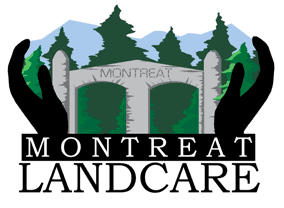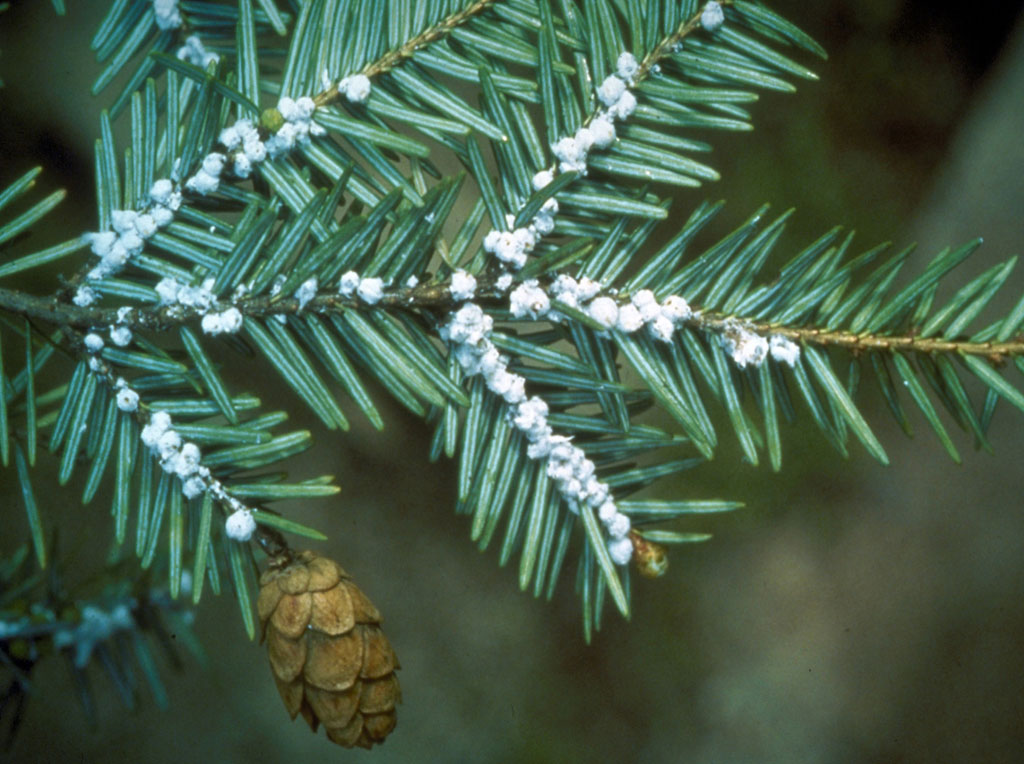Hemlock Restoration Initiative Link
Hemlocks and the Hemlock Woolly Adelgid
One of the major invasive pest problems of the east coast of the United States is the destruction of the Hemlocks by a tiny insect called the Hemlock Woolly Adelgid (Adelges tsugae). It was introduced accidentally from southern Japan and is endemic to Asia. In Asia it is not as destructive as there are native predators and more resistant tree species. This tiny insect can kill the Hemlocks in the eastern United States in 3 to 5 years, even large old-growth Hemlocks. It affects both the Eastern Hemlock (Tsuga canadensis) as well as the local endemic Carolina Hemlock (Tsuga caroliniana). Since the hemlocks are evergreen trees that are found near streams and moist areas, they are an important tree for the environment and protect the fish populations in the streams by keeping the water temperatures low. There is not an equivalent tree species that with take the place of the hemlocks.
The Adelgid is a tiny insect that lives at the base of the needles of the Hemlocks and sucks the juices from the needle and injects saliva. The needles will die and then limits the nutrients and growth of the tree from the massive loss of the needles. The adelgid gets its name from the white cottony “cocoon” at the base of the needles that encases and protects the adelgid and the nymphs. To check for infestation, turn a branch over and see the white cottony clumps at the base of the needles. (See below for treatment measures available.)
Montreat Activities
Over the years, the Montreat Conference Center has been treating selective hemlocks in the most visable areas of the Center. In particular, trees near Lake Susan, the Post Office, and around the center of the community have been treated several times. Other selective treatments have been done at the Walk Jones Wildlife Sanctuary and at the Memorial Garden near the gate.
In 2008, a Montreat resident, John Johnson approached Montreat Landcare to initiate a grassroots Hemlock protection project called “Save the Hemlocks along Flat Creek.” John worked with Landcare to disseminate information and conduct a fund raising campaign to treat all the hemlocks along Flat Creek from the gate to the lake that had not been treated by the Conference Center. This effort resulted in $6,600 being raised for treatments. An attempt was also made to treat hemlocks from the lake to the Greybeard trailhead but most were already dead, except for 28 treated in the campground.
Appalachian Arborists performed the work in two separate treatments along the creek and in the campground. With extra funds remaining, a large stand of Carolina Hemlocks above Chapman Road was also treated. Appalachian Arborists, at their expense also treated some along Puncheon Creek on the way up the Lookout Trailhead. In total, 526 hemlocks were treated.
In 2015 another Save Our Hemlocks project was launched in cooperation with a collection of Western North Carolina organizations entitled the Hemlock Restoration Initiative. A Montreat Task Force of Joe Standaert, Rusty Frank, John Johnson and Philip Arnold conducted a $15,000 fund raising drive from local organizations and individuals and also obtained a NC State grant for $5,000 to educate the community of the value of the hemlock tree, the devastation caused by the woolly adelgid and the benefits of bio control offered by the Laricobius nigrinus predator beetle. Montreat College students produced a portable poster to use at displays and also a permanent trail sign located by the Post Office parking lot. Individuals were encouraged to chemically treat hemlock trees on their own private property. On public lands, green spaces, and property of not-profit organizations, Appalachian Arborists chemically treated an additional 231 large hemlock trees, and the Task Force, working through the Landcare Committee and the Town of Montreat, purchased and released 2,700 Laricobius beetles, at $5.00 each, thru October 2016. A report on the grant activities can be downloaded here.
Adelgid Treatment Options
The Hemlock Wooly Adelgid (HWA) can be treated in several ways, depending on the size of the tree and funds available. All chemical treatment options require continued re-treatments, even if 3 to 5 years apart. Since the HWA has its cottony, protective “cocoon” for most of the year, some of the treatment options require timing for the two periods of the year when the insects are “out” of their protection. Systemic treatments can be done at any time, but are better when the trees are actively growing and pulling soil water from the ground. Options include:
- Small trees: A homeowner with small trees (less than 20 feet) can effectively treat the trees by using a handheld sprayer and drenching the branches. The ideal time is Mid-March to mid-April and again in September and October. You can use an insecticidal horticultural soap or horticultural oil. The insecticidal soap kills by contact and the oil sprays kill by suffocating. You must drench all the branches for ideal coverage.
- Larger Trees: You can use a systemic soil drench. This is applied, based on tree diameter, by pouring (or injecting) the insecticide at the base of the tree. The tree absorbs the chemical into its vascular system and the feeding insects are killed. Can be applied March to June or September to November. It will last for two years. Common brands are Bayer Tree & Shrub Insect Control Concentrate or Merit insecticide that contains the chemical Imidacloprid. For very large trees, a professional can do a soil injection or an injection in the trunk of the tree.
- Biological Control: There is a predatory beetle, Laricobius nigrinus, native to the northwestern United States that feeds on the adelgid. Not for the homeowner, but the National Parks and the Forest Service have been raising and aerial releasing populations of this beetle in large areas like the Smokies. Results have been mixed but with considerable success in Avery County, NC.
References:
An internet search for “Hemlock Wooly Adelgid” will produce many articles and web sites regarding the insect, its effects, and treatment options.
A select few sites are:
Wikipedia, Hemlock Wooly Adelgid Fact Sheet
For information about managing trees in Montreat, consult the Tree Management Guide. Also Available through the town office.

